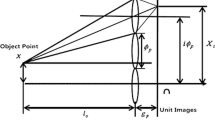Abstract
In this paper, we propose a three-dimensional (3D) integral image display method that uses the similarity of corresponding points in a series of axially recorded images. First, we calculate the corresponding points of a 3D object, in view of the proportional relationship of the distances of points in the elemental images collected, using axially distributed sensing (ADS). Next, we extract the depth map using the minimum error of the color values of the corresponding points. Finally, we use the color image and depth map to generate an elemental image array without the need for a lens array. This approach can display a 3D image in integral imaging. To show the usefulness of the method, we obtain the elemental images using ADS through the 3ds Max, and the experimental results demonstrate that the method proposed can extract a depth map for the 3D integral image display.
Similar content being viewed by others
References
B. Javidi and A. Murat Tekalp, Proc. IEEE, 105, 786 (2017).
Y. Piao, M. Zhang, D. Shin, and H. Yoo, Opt, Lett., 38, 3162 (2017).
P. A. Savas Tay, R. Blanche, A. V. Voorakaranam, et al., Nature, 451, 694. (2008).
G. E. Favalora, Computer, 38, 37 (2005).
V. J. Traver, P. Latorre-Carmona, E. Salvador-Balaguer, et al., IEEE Signal Process. Lett., 24, 171 (2017).
M. Cho, H. Yun, K. Inoue, and B. Cho, Three-Dimensional Imaging, Visualization, and Display, International Society for Optics and Photonics (2018).
Y. Kim, K. Hong, and B. Lee, 3D Res., 1, 17 (2010).
A. Stern and B. Javidi, Proc. IEEE, 94, 591 (2006).
J. S. Jang and B. Javidi, Opt. Lett., 27, 1144. (2002).
Y. Piao, L. Xing, M. Zhang, and B. G. Lee, Opt. Lasers Engin., 88 Compl., 153 (2017).
R. Schulein, M. Daneshpanah, and B. Javidi, Opt. Lett., 34, 2012 (2009).
M. LaRosa and B. Javidi, “Experiments with three-dimensional optical microscopy using axially distributed sensing,” in: Proceedings of 11th Euro-American Workshop on Information Optics (WIO 2012), 20–24 August 2012, Quebec City, Quebec, Canada, IEEE Publ. (2013).
X. Xiao, M. Daneshpanah, M. Cho, and B. Javidi, J. Display Technol., 6, 614 (2010).
S. P. Hong, D. Shin, B. G. Lee, et al., Opt. Express, 20, 23044 (2012).
D. C. Hwang, D. Shin, S. C. Kim, and E. Kim, Appl. Opt., 47, D128 (2008).
G. Li, K. C. Kwon, G. H. Shin, et al., J. Opt. Soc. Korea, 16, 381 (2012).
Author information
Authors and Affiliations
Corresponding author
Rights and permissions
About this article
Cite this article
Yang, JX., Wang, Y. 3D Integral Imaging Display Processing Using the Similarity of Corresponding Points in Axially Recorded Images. J Russ Laser Res 41, 390–398 (2020). https://doi.org/10.1007/s10946-020-09891-9
Received:
Published:
Issue Date:
DOI: https://doi.org/10.1007/s10946-020-09891-9




